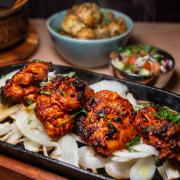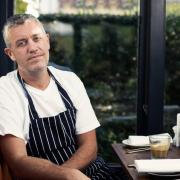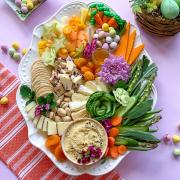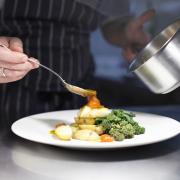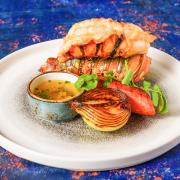Most of us would focus on the views across the Dee Estuary but foraging guide Matt Normansell has good reason to keep his gaze downward, writes Martin Pilkington

A brisk stroll along the shore at Thurstaston will pique anyone’s appetite, and there are fine ways to satisfy culinary cravings minutes from the beach. But you needn’t leave the sands to discover new taste sensations.
On such walks most of us would focus on the fabulous views across the Dee Estuary. Foraging guide Matt Normansell, however, directs his gaze down at the ground around him. ‘If you know what you’re looking for there’s a huge variety of plants and seafood here,’ he promises. And in two hours of pleasant rambling along sands, mud-flats and cliff top he delivers on that, his foraging basket full when we finish.
It helps of course that he knows the territory from previous visits with parties of clients. On arrival Matt heads straight to a partly submerged rock: ‘This is my mussel rock,’ he explains, and promptly proves it by scooping out a dozen or so from the surrounds. They’ll join the periwinkles found atop the same stone in a seafood dish. But there’s a caveat: ‘You need to be careful,’ he says: ‘I check the local water quality reports before gathering anything, and I’ll flush these in salt water – 35g per litre of water – for about five to six hours, then change the water and do it again adding a sprinkle of oats to help get the grit out.’
Mussels are easy to identify, but how about Sea Purslane? Matt finds some growing in unpromisingly muddy ground, and the plant itself, low-growing and rather tough-looking, doesn’t exactly shout ‘eat me.’ The stubby oval leaves are, however, delicious, a salty snack complete with pleasing crunch. Next to it is a patch of Sea Aster, its shoot-tip reminiscent of cucumber perhaps, and apparently much sought after by trendy chefs: ‘They’ll pay £25 per kilo,’ says Matt: ‘I’m not against some commercial foraging, but you have to forage sustainably, not endangering the plants or damaging the environment.’
He will in fact shortly be providing Manchester’s 1847 vegetarian restaurant with ingredients for a ‘wild’ event: ‘Restaurants are always looking for the next new thing, new flavours, so where once it may have been elderflower panna cotta now it’s foraged leaves.’
Choice is not lacking. At the foot of Thurstaston’s cliffs we find plenty of sea beet, for example: ‘It’s the granddad of Swiss chard, ruby chard, and sugar beet,’ he says: ‘You can eat the tiniest leaves in salads, and cook slightly larger ones like kale.’ The flavour is, unsurprisingly, very beet-y.
The same logic applies to shoots of Sea Radish he finds nearby, peeling the tough skin to reveal a tender core with a nice radish-y heat. In the same patch there’s vetch, the leaf-tip of which tastes just like pea-shoots, another winner.
A short scramble up the cliff takes us to a gorse bush. Matt picks and eats a couple of flowers: ‘People reckon it tastes like coconut. Don’t see it myself. But they decorate a salad nicely, and you can make syrups and cordials with them too.’
Along the cliff-top path he discovers some Alexanders, a plant grown commercially for its stems and leaves until the 18th century, when celery, improved by growers, supplanted it as both pot herb and vegetable.
Matt spent years learning how to recognize plants and fungi before setting up his Eden Wild Food business: ‘There’s a herbalist tradition in the family, and as a kid I’d go with my parents picking berries for jam. Then when I was 18 I got Richard Mabey’s classic ‘Food for Free’ book, which fired my imagination. Foraging became my passion – the process of finding out new stuff is just as rewarding as actually gathering food, I’ve got a whole library of books on the subject. Two years ago my wife pushed me to do it professionally, and here I am.’
His role still brings new discoveries: the gales before our trip uprooted a sea-beat plant, so Matt harvests a few inches of the edible root to try: ‘It’s illegal to dig them up, so this is a very rare opportunity,’ he says.
It’s not just the law that can threaten the unwary forager: ‘A friend was looking for hemlock water-dropwort to show it to people, and picked the pretty similar Alexanders by mistake. Hemlock water-dropwort is the most poisonous plant in Europe. Imagine getting it wrong the other way around!” w
www.edenwildfood.co.uk
Foraging tips
Legislation relating to seashore foraging is complicated. You’re unlikely to get into bother if you:
- pick a few leaves here and there
- don’t dig up roots
- don’t cut or pick the whole plant
- avoid any protected species!




